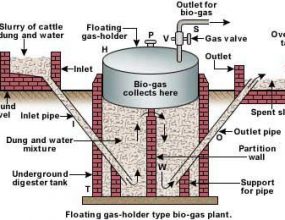Biogas is a type of biofuel that is naturally produced from the decomposition of organic waste. When organic matter, such as food scraps and animal waste, break down in an anaerobic environment (an environment absent of oxygen) they release a blend of gases, primarily methane and carbon dioxide. Because this decomposition happens in an anaerobic environment, the process of producing biogas is also known as anaerobic digestion.
Anaerobic digestion is a natural form of waste-to-energy that uses the process of fermentation to breakdown organic matter. Animal manure, food scraps, wastewater, and sewage are all examples of organic matter that can produce biogas by anaerobic digestion. Due to the high content of methane in biogas (typically 50-75%) biogas is flammable, and therefore produces a deep blue flame, and can be used as an energy source.|
Organic input materials such as foodstuff remnants, fats or sludge can be fed into the biogas plant as substrate.
- Renewable resources such as corn, beets or grass serve as feed both for animals such as cows and pigs as well as for the micro organisms in the biogas plant.
- Manure and dung are also fed into the biogas plant.
- In the fermenter, heated to approx. 38-40 °C, the substrate is decomposed by the micro organisms under exclusion of light and oxygen. The final product of this fermentation process is biogas with methane as the main ingredient. But aggressive hydrogen sulphide is also contained in the biogas. A fermenter made of stainless steel has the clear advantage that it withstands the attacks of the hydrogen sulphide and is usable for decades. Furthermore, a stainless steel fermenter provides the opportunity to operation the biogas plant also in the thermophile temperature range (up to 56 °C).
- Once the substrate has been fermented, it is transported to the fermentation residues end storage tank and can be retrieved from there for further utilisation.
- The residues can be utilised as high quality fertiliser. The advantage: Biogas manure has a lower viscosity and therefore penetrates into the ground more quickly. Furthermore, the fermentation residue quite often has a higher fertiliser value and is less intense to the olfactory senses.
- But drying it and subsequently using it as dry fertiliser is also an option.
- The biogas generated is stored in the roof of the tank and from there it
- is burned in the combined heat and power plant (CHP) to generate electricity and heat.
- The electric power is fed directly into the power grid.
- The heat generated can be utilised to heat building or to dry wood or harvest products.
- Processing of biogas
- Gas supply to the national grid or gas filling stations






